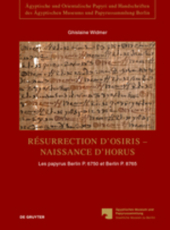 Neuerscheinungen 2016Stand: 2020-02-01 |
Schnellsuche
ISBN/Stichwort/Autor
|
Herderstraße 10
10625 Berlin
Tel.: 030 315 714 16
Fax 030 315 714 14
info@buchspektrum.de |

Ghislaine Widmer
Résurrection d´Osiris - Naissance d´Horus
Les papyrus Berlin P. 6750 et Berlin P. 8765, témoignages de la persistance de la tradition sacerdotale dans le Fayoum à l´époque romaine
2016. XIII, 462 S. Numerous facsimiles, 16 color plates. 300 mm
Verlag/Jahr: DE GRUYTER 2016
ISBN: 3-11-042509-2 (3110425092)
Neue ISBN: 978-3-11-042509-3 (9783110425093)
Preis und Lieferzeit: Bitte klicken
Das Ägyptische Museum und Papyrussammlung der Staatlichen Museen zu Berlin, Stiftung Preußischer Kulturbesitz, ist ein Doppelmuseum. Neben den ca. 40.000 archäologischen Objekten umfasst es rund 60.000 Papyri und Handschriften, die zu einem großen Teil noch unpubliziert sind. Mit dieser neu gegründeten Publikationsreihe möchte die Ägyptische und Orientalische Papyrussammlung die Möglichkeit eröffnen, dass in Zukunft große Texteditionen und Einzelstudien zu ihren Texten in hieroglyphischer, hieratischer, demotischer, koptischer, aramäischer, hebräischer, persischer, arabischer, syrischer und äthiopischer Sprache und Schrift publiziert werden können.
First complete edition of two demotic manuscripts from the early Roman period. These papyri, written in the distinctive Soknopaiu Nesos hand (Fayyum), are inscribed with religious texts for which only a few parallels are known. Papyrus Berlin P. 6750 contains 10 fragmentary columns and can be described as a compendium of liturgical texts, including among others glorifications, lamentations, litanies of names and hymnic parts. The first seven columns are centred on Osiris, foremost in the West, with the description of his ´resurrection´; the last three columns, which deploy more recent grammar constructions, are concerned with the birth of Horus-the-son-of-Isis inside the mammisi, and his accession to the throne. Papyrus Berlin P. 8765, in its present state, is made up of two large columns containing litanies of names and it is a close parallel to a section of papyrus Berlin P. 6750.? There is reason to think that the main papyrus was written by a scribe from Soknopaiu Nesos in the 1st century A.D. who both compiled earlier sacerdotal texts and composed new ones, combining traditional themes. This enterprise reflects the surge in creativity that can be witnessed throughout Egypt in the religious sphere during the early Roman period.
"[...] die vorliegende sorgfältige und detaillierte Publikation [stellt] einen außerordentlich wichtigen Schritt im Rahmen der Erschließung nicht-funerärer demotischer religiöser Texte sowie generell der ägyptischen religiösen Traditionen der Römerzeit dar[...] und [sollte] deshalb von jedem an Religion interessierten Ägyptologen gelesen werden [...]"Joachim Friedrich Quack in: olzg-2016-0125, 314-317 "[...] the book has already proven to be useful in scholarly daily routine. Therefore, it may be safe to say that Widmer´s book is important and good."Martin Andreas Stadler in: Bryn Mawr Classical Review 2017.03.36
Ghislaine Widmer, Université Lille 3, Frankreich.


